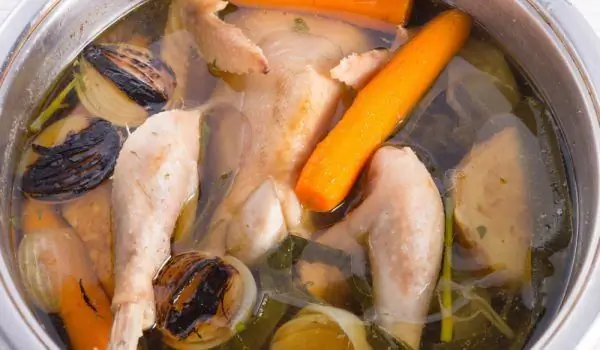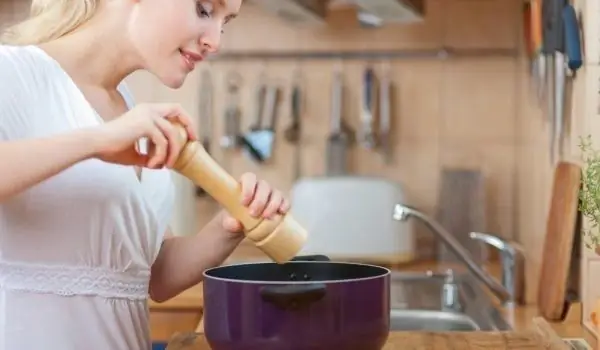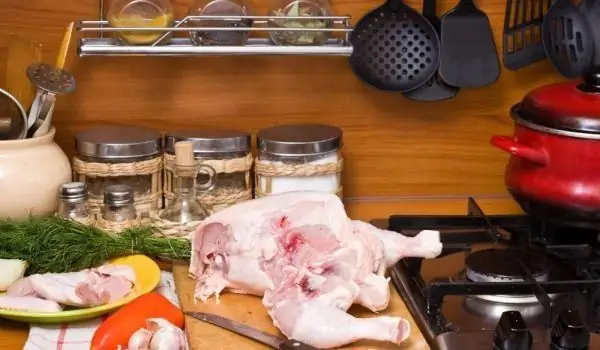2025 Author: Jasmine Walkman | [email protected]. Last modified: 2025-01-23 10:18
An important condition for delicious and quality cooking is the right choice of cooking utensils - pots, pans, pans, pots and more. During the heat treatment, the dishes used should not give the dish a side color, smell or taste.
Unlike electric and gas stoves with built-in thermostats, cookers that work with wood, coal, naphtha or a combination do not give a constant temperature. Therefore, when working with them, it is necessary to use vessels that help to convert uneven heating into uniform.
The most suitable for this purpose are vessels with thick bottoms and walls, which are not good conductors of heat and therefore slowly heat up and cool down slowly, as a result of which a uniform temperature is obtained in them and conditions are created for the most complete extraction of food and the flavors of the products. For this reason, dishes are best prepared in pots, pots, jugs and more.

For dishes prepared by cooking or stewing, dishes made of yen - fireproof glass, clay and enameled cast iron and special dishes with double bottoms are recommended. The dishes cooked in these dishes retain their taste, color and aroma to a large extent. However, when working with these vessels, their shortcomings must be known.
Glass refractory vessels (Yen vessels)
When using them on an open fire, they must have a well-dried surface and be placed on a fireproof net. The liquid added during cooking must be at a temperature close to the temperature of the liquid and the products in the dish. These containers should not be left without liquid during the heat treatment. Adherence to the listed recommendations protects the glass refractory vessels from bursting.
The pottery
Earthenware should be with a glaze that does not contain lead impurities. Ready-made dishes should not be kept in them for a long time, so that the dish does not absorb the smell of the dish. Washing these dishes should be done with a brush to perfectly clean the inside, which is often in places with pores and edges.
Cast iron vessels
Enameled cast iron cookware is less capricious and easier to work with. It is only necessary that they have a strong, uncracked and without chipped enamel surface.
Stainless steel and aluminum cookware are suitable for cooking and frying because they are good conductors of heat.
Stainless steel cookware
Stainless steel cookware does not chemically react with food in the dish. They are healthy, easy to clean and retain the good taste, color, aroma and quality of the dish.
Aluminum containers

Aluminum containers react easily with the strong acids and bases contained in some plant and animal products. For example, the mashed potatoes prepared in an aluminum container are oxidized by the contact of the contained amino acids with the metal and the air, due to which it darkens and its quality deteriorates.
Dishes containing tomatoes, wine, eggs, yoghurt, etc. should not be prepared in aluminum containers. These dishes can be used to prepare dishes from neutral products such as cooking fresh milk with rice and for short-term heat treatment such as frying and baking. Aluminum bowls for creams and serving hot soups are also used. It is not recommended that ready meals other than fresh milk stay in these containers.
Copper vessels
Copper vessels are easily oxidized and should not be used for heat treatment without tinning. However, at the high temperature required for frying and baking, the tin melts. Therefore, these vessels can be used mainly for stewing and cooking with adjustable heat sources.
In addition to the dishes for ensuring the good quality of the dishes, the equipment with which they are prepared or poured is also important, as well as the services in which they are served directly. It is necessary to have at least two cutting boards in order to comply with the basic hygiene requirements at work. The first is used on the one hand for slicing raw animal products and on the other for raw plant products.
The second is used on one side for bread, and the other - for cold snacks such as cheese, sausages and more.

The most suitable for pouring are ladles, grate blades and other similar utensils made of stainless steel, enameled cast iron and wood.
Foodstuffs must be cut with stainless steel knives to prevent oxidation, which leads to loss of vitamins. The same goes for spoons and forks used immediately in eating.
In addition to stainless steel, silver-plated utensils can also be used for dining. The most used dining plates are porcelain due to their ability to retain heat for a longer time.
Recommended:
Culinary Textbook: How To Cook Meat And Vegetables?

In order to obtain a strong broth saturated with nutrients, it is necessary to place the products (meat, bones, fish or vegetables) in cold water and heat them slowly on the stove, and it is even better to cut them into small pieces. pieces.
Cooking In Cheap Household Utensils - Are There Any Dangers?

Every housewife will prefer to buy new cooking utensils that are convenient and at the same time cheap. But it often happens that cheap dishes are harmful to health, because the food cooked in them absorbs toxins from the material from which the dish is made.
What Utensils And Utensils Should Be In Every Kitchen

A well-arranged kitchen, equipped with the necessary equipment, is very important for the successful work of the hostess. The more kitchen utensils and cutlery the housewife has, the more pleasant and easy her work is. Kitchen utensils must be made of a material that does not alter the appearance, taste, aroma of food and does not form chemical compounds with food that could cause poisoning.
Measuring The Quantity Of Products With The Help Of Household Utensils

Here is the approximate amount, weight of some products measured with household utensils: 1 tsp sugar - 5-7 g; flour - 5-6 g; semolina - 5-6 g; rice 7 g; starch - 5 g; 1 tbsp. toasted flour full tbsp. - 15 g; toasted flour equal to tbsp.
Household Utensils In Spanish Cuisine

Each kitchen uses its own typical household appliances and utensils, without which the preparation of local specialties would be unthinkable. Just as the Japanese have their own utensils, such as a bamboo mat and various forms for making sushi, so the Spaniards have the typical tools for preparing their traditional dishes.

